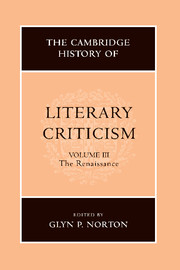Book contents
- Frontmatter
- Introduction
- READING AND INTERPRETATION: AN EMERGING DISCOURSE OF POETICS
- POETICS
- I Humanist classifications
- II The rediscovery and transmission of materials
- III Rhetorical poetics
- IV Literary forms
- 20 Italian epic theory
- 21 The lyric
- 22 Renaissance theatre and the theory of tragedy
- 23 Elizabethan theatrical genres and literary theory
- 24 Defining comedy in the seventeenth century: moral sense and theatrical sensibility
- 25 Dialogue and discussion in the Renaissance
- 26 The essay as criticism
- 27 The genres of epigram and emblem
- 28 Humour and satire in the Renaissance
- THEORIES OF PROSE FICTION
- CONTEXTS OF CRITICISM: METROPOLITAN CULTURE AND SOCIO-LITERARY ENVIRONMENTS
- VOICES OF DISSENT
- STRUCTURES OF THOUGHT
- NEOCLASSICAL ISSUES: BEAUTY, JUDGEMENT, PERSUASION, POLEMICS
- A SURVEY OF NATIONAL DEVELOPMENTS
- Bibliography
- Index
- References
28 - Humour and satire in the Renaissance
from IV - Literary forms
Published online by Cambridge University Press: 28 March 2008
- Frontmatter
- Introduction
- READING AND INTERPRETATION: AN EMERGING DISCOURSE OF POETICS
- POETICS
- I Humanist classifications
- II The rediscovery and transmission of materials
- III Rhetorical poetics
- IV Literary forms
- 20 Italian epic theory
- 21 The lyric
- 22 Renaissance theatre and the theory of tragedy
- 23 Elizabethan theatrical genres and literary theory
- 24 Defining comedy in the seventeenth century: moral sense and theatrical sensibility
- 25 Dialogue and discussion in the Renaissance
- 26 The essay as criticism
- 27 The genres of epigram and emblem
- 28 Humour and satire in the Renaissance
- THEORIES OF PROSE FICTION
- CONTEXTS OF CRITICISM: METROPOLITAN CULTURE AND SOCIO-LITERARY ENVIRONMENTS
- VOICES OF DISSENT
- STRUCTURES OF THOUGHT
- NEOCLASSICAL ISSUES: BEAUTY, JUDGEMENT, PERSUASION, POLEMICS
- A SURVEY OF NATIONAL DEVELOPMENTS
- Bibliography
- Index
- References
Summary
Although medieval Europe, like all cultures, enjoyed wit and satire, Renaissance humanists and others had a specific interest in classical views of the risible and in definably classical genres. The interest, however, was seldom expressed with much subtlety even by major critics. When Sir Philip Sidney, for example, briefly mentions the ‘bitter but wholesome Iambic, who rubs the galled mind’ and the gentler ‘Satyr’ who ‘sportingly never leaveth till he make a man laugh at folly’, or when Joachim du Bellay advises the French to give up inept native forms and imitate such poets as Horace in ‘modestement’ taxing the age's vice, the limitations of Renaissance genre theory are clear. Renaissance scholars and writers thought about the history of satire and the nature and function of humour, but thanks in part to a tendency to prize the moral and didactic with just a nod or two at the recreative, their speculations – even those of the great Isaac Casaubon – lagged behind the imaginative complexity of actual practice. A certain unease in Renaissance commentary on satire and humour can also be explained by the need, when following the ancients, to adapt classical genres and styles to a culture with dukes and kings, not senators and emperors, to new media and new means of censorship, and to a religion that urges us to love our enemies, not to humiliate them into suicide as, it was said, the ancient satirist Archilochus had done when he invented the iambic. Those who imitated ancient humour are therefore often careful to say that laughter repairs the hard-working body and spirit, that an acid-dipped pen can serve as a doctor's scalpel, that fools and villains need a good rhetorical drubbing, that one may bite back at detractors, or that those who wince at satire are probably guilty of something.
- Type
- Chapter
- Information
- The Cambridge History of Literary Criticism , pp. 284 - 292Publisher: Cambridge University PressPrint publication year: 1999
References
- 2
- Cited by



